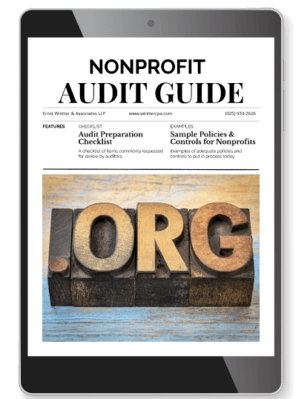Nonprofit contributions are not always eligible for tax deductions, even when someone itemizes their deductions and donates to tax-exempt organizations. One such situation is “quid pro quo” donations. The IRS defines quid pro quo contributions as cases where goods or services are provided in return for a gift that’s worth less. Our California nonprofit audit clients receive comprehensive guidance, but here is a summary of the key guidelines.
Be Responsible | Nonprofit Contributions
By law, receiving quid pro quo donations creates reporting obligations for your nonprofit. For instance, a quid pro quo donation of over $75 triggers the requirement that you let the donor know that this is considered a quid pro quo. Your written notice should advise the donor that they are only allowed to deduct the amount of the donation that exceeds the value of the goods and services received. At the same time, be sure to give a good faith estimate of how much the goods and services provided are worth.
According to IRS rules, nonprofits must provide these disclosures to potential donors when soliciting these contributions, in addition to the written acknowledgement. One of the more common examples of this sort of contribution is a charity dinner. In this case, you should disclose the amount of the dinner that covers the expenses, and how much is tax-deductible. Also, regulations require that the disclosure is easy for a donor to read, rather than buried in the fine print. Examples of disclosures can be found in IRS Publication 1771, “Charitable Contributions — Substantiation and Disclosure Requirements.”
Valuing goods and services
First thing’s first, though. In order to tell donors how much goods and services are worth, you have to assign a price to them. Going out to a restaurant with potential donors is an easy one to price, because if the nonprofit pays the tab for the dinner, there is a defined amount of money spent on the restaurant services. The per-person restaurant tab is the fair market value, and anything extra is tax deductible for the donor.
On the other hand, gala dinners are much more difficult to price. They often include live music in addition to the dinner. Often, the banquet hall will discount the food and your nonprofit gets the band’s services for free. In this case, the discount and free services are themselves contributions to your organization. However, you still have to establish the value to your gala attendees for tax purposes. Generally, the way to do this is to consider what it would cost someone to attend an event like this, if it was on the open market. That means finding out how much the services would normally cost at a similar venue. Alternately, ask the banquet hall and performers what their normal fee is, and divide it among the attendees.
Donated auction items are slightly different. In this case, find out what a buyer would normally pay for the items in the open marketplace. To ensure compliance, report this estimated value on the item’s bid cards.
Risking penalties
Like so many other tax questions, there are exceptions to the quid pro quo rules. However, you should be aware that there are penalties for failure to provide compliant acknowledgment and disclosures to their donors. Our qualified nonprofit tax professionals can help you navigate these exceptions and requirements.
Download our Nonprofit Audit Guide to be prepared for your next audit.








